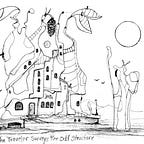A Different Approach
Before the growing season comes the election season in Sioux Falls. I will get back to updates on the micro-prairie soon (the bloodroot is blooming) but first I want to talk about things that are important to those of us who live in Sioux Falls.
The city council election is Tuesday, April 9th. The city is at a cross road and in need of new ideas. I have talked about Strong Town ideas on this blog before because they are the type of neighborhood and city building ideas we need. Now I want to talk about the guy who introduced me to Strong Towns and who is now running for an at-large city council seat. His name is Jordan Deffenbaugh and here is a short article I wrote to endorse his candidacy. Please give it a look even if you don’t live in Sioux Falls. And if you do live in Sioux Falls please vote on Tuesday. Here is the article.
…………………………………………………………………………………………………
I went to the downtown library for what was supposed to be a citizen input meeting on a proposed project. I looked at the colorful architectural renderings and engineering drawings and realized that a lot of work had already been done on the project. If the meeting was supposed to be an input session why had so much work been done before they got our input. That is when I realized that the project was a done deal — it was going to happen and they really didn’t care about our input. Influential parties convinced the city that this project would be a good thing for someone. The neighborhood that would be disrupted by the project should be grateful for the investment. But did anyone ask the affected neighborhood if they thought such a project would be good for them? No, that probably didn’t happen. Unfortunately, this scenario has been repeated many times here in Sioux Falls. But does it have to be that way?
A new breed of leaders want to try a different approach — an approach where neighborhood residents are asked their opinions on what their neighborhood needs before any plans are drawn up. These leaders don’t want giant top-down projects that disrupt neighborhoods but rather bottom-up projects that originate in neighborhoods and benefit the people in the neighborhoods the most. How should the city planning department go about conducting such an input session? Let’s look at a type of input session that is already being used successfully in Sioux Falls.
The first requirement for an effective input session is to create a safe space for the participants. This means not only physically safe but also safe to express viewpoints without fear of being ignored or belittled. Once a safe environment is established the session begins by establishing the agenda.
A good input session is self organizing. The first few minutes are spent making a list of what people want to talk about — not predetermined by someone. The agenda is decided by the people who show up. Once the topics of discussion are established people can break into smaller groups to discuss the topics in more detail. The goal is to establish short term goals (30 to 90 days) that will move the selected projects forward. It is really helpful to have achievable goals that show progress and keep things moving. Participants need to know that they don’t have to solve the world’s problems in one input session.
The key to effective input sessions is to stress that the opinions of city representatives and the opinions of citizen participants have the same weight. For example, if someone from the engineering department says the speed limit on a certain street has to be 30 mph but a citizen says that 30 mph is unsafe, the city doesn’t automatically win. If citizens make a case for lower speeds the city has to actually prove their contention for higher speeds. This is not how it usually works now but new leadership in the city council can change that. That is why I am endorsing Jordan Deffenbaugh for city council member at large.
Jordan has been conducting input sessions like this for some time now. A “Sidewalk Seminar” I put on in my yard a few years ago about the benefits of native plants was the result of such a session. We were challenged to come up with projects that we could do in the next 30 days to move the needle on projects to improve the city. Setting goals gets us from the talking and dreaming phase to actually doing something. I think Jordan has a good grasp of how to do this. He will be able to build coalitions to get things done that benefit all citizens. Just like I planted native plants to help the environment, Jordan can plant ideas that will help Sioux Falls. Thanks for reading this.
